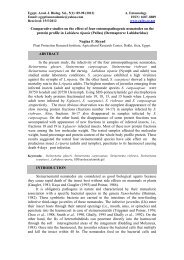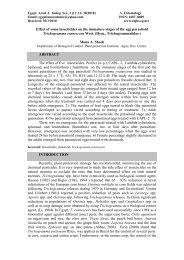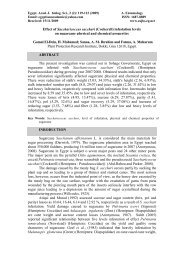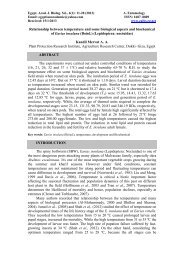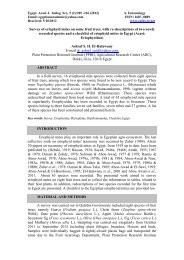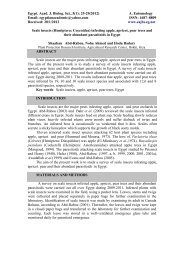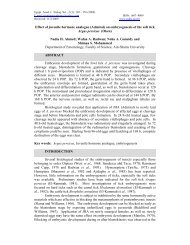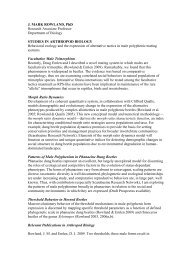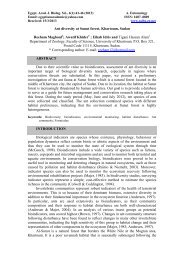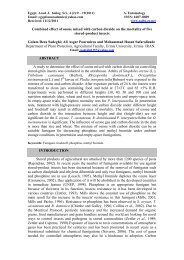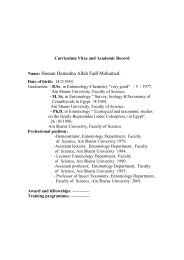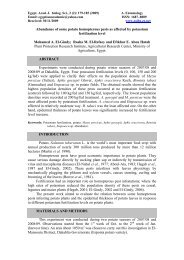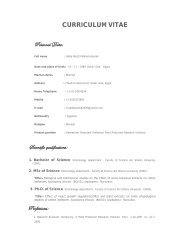Heat Requirements for the Development of the Black cutworm ...
Heat Requirements for the Development of the Black cutworm ...
Heat Requirements for the Development of the Black cutworm ...
Create successful ePaper yourself
Turn your PDF publications into a flip-book with our unique Google optimized e-Paper software.
<strong>Heat</strong> <strong>Requirements</strong> <strong>for</strong> <strong>the</strong> <strong>Development</strong> <strong>of</strong> <strong>the</strong> <strong>Black</strong> <strong>cutworm</strong>, Agrotis ipsilon 121<br />
The developmental zero <strong>for</strong> this stage was 9.83C as illustrated graphically<br />
by extrapolation in Fig. (3).The average <strong>of</strong> <strong>the</strong>rmal heat units <strong>for</strong> A. ipsilon pupae<br />
was 183.5dd’s as estimated by <strong>the</strong> <strong>the</strong>rmal summation equation.<br />
The three observed values <strong>for</strong> <strong>the</strong> pupal rate <strong>of</strong> development at <strong>the</strong><br />
temperature range from 20 to 30C gave a remarkable good fit to <strong>the</strong> calculated<br />
temperature – velocity line having <strong>the</strong> <strong>for</strong>mula Y = 0.545 x - 5.35 (Fig. 3).<br />
R a t e o f d e v e l(1/t o p x1 m 0e ) 0n<br />
t<br />
1 4<br />
1 2<br />
1 0<br />
8<br />
6<br />
4<br />
2<br />
0<br />
r = 0 . 9 9 K = 1 8 3 . 5<br />
y = 0 . 5 4 x5 - 5 .3 5<br />
0 5 1 0 1 5 2 0 2 5 3 0 3 5<br />
T e m p e r a t u r e ( ° C)<br />
F i g . ( 3 ) : T h e r e g r e s s i o n l i n e o f t h e r e l a t i o n b e t w e e n t h e<br />
r a t e o f d e v e l o p m e n t o f A . i p s i l o n p u p a e a n d d i f f e r e n t<br />
c o n s t a n t t e m p e r a t u r e s .<br />
Fig. (3): The regression line <strong>of</strong> <strong>the</strong> relation between <strong>the</strong> rate <strong>of</strong> development <strong>of</strong> A. ipsilon pupae and<br />
different constant temperatures.<br />
Adult stage<br />
1-Pre-Oviposition period<br />
Data in Table (4) show that <strong>the</strong> mean period required <strong>for</strong> maturation <strong>of</strong> <strong>the</strong><br />
ovaries and starting to egg laying, decreased as <strong>the</strong> temperature increased (from 4.2<br />
days at 20C to 2.00 days at 30 C). The analysis <strong>of</strong> variance showed significant<br />
differences (P < 0.01) between <strong>the</strong> means <strong>of</strong> <strong>the</strong> pre-oviposition period at all <strong>the</strong><br />
tested constant temperatures.<br />
Table (4): Duration <strong>of</strong> A. ipsilon pre-Oviposition period under different constant temperatures and its <strong>the</strong>rmal<br />
requirements.<br />
Temp.<br />
(°C)<br />
Pre-Oviposition<br />
Period<br />
(days ± S.E)<br />
Expect<br />
duration<br />
Rate <strong>of</strong><br />
increase<br />
%<br />
Expect rate<br />
<strong>of</strong> increase %<br />
to<br />
(˚C)<br />
Degree<br />
Days<br />
(DD΄s)<br />
20 4.2 ± 0.17 a 4.27 23.81 23.41<br />
37.5<br />
25 2.8 ± 0.33 b 2.73 35.71 36.5 11.06 39.0<br />
30 2.00 ± 0.11 c 2.01 50.00 49.6 37.9<br />
Average 38.1<br />
L.S.D 0.37<br />
The lower threshold <strong>of</strong> development was 11.06C. The average <strong>of</strong> total<br />
<strong>the</strong>rmal units was 38.1dd’s as calculated by <strong>the</strong>rmal summation equation.



